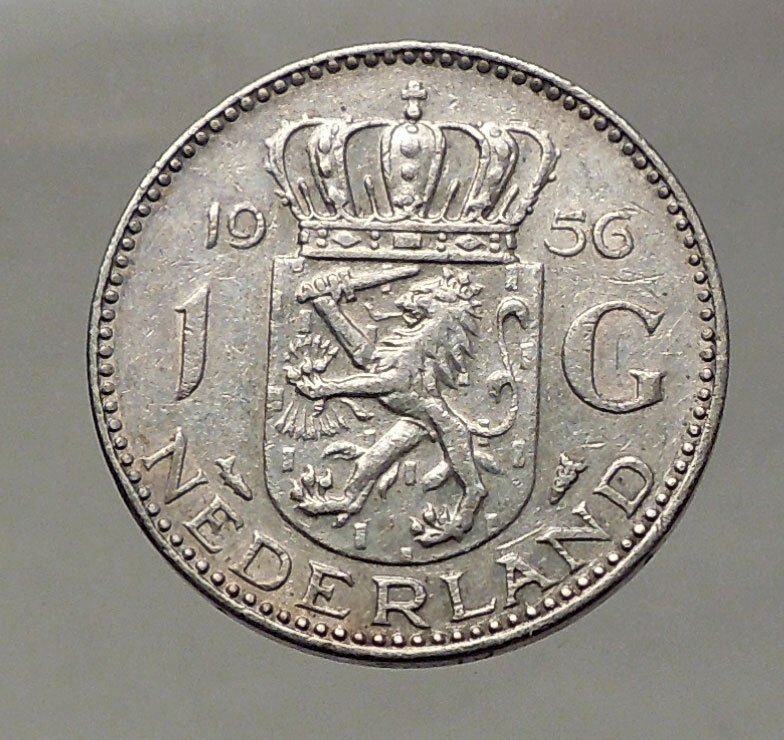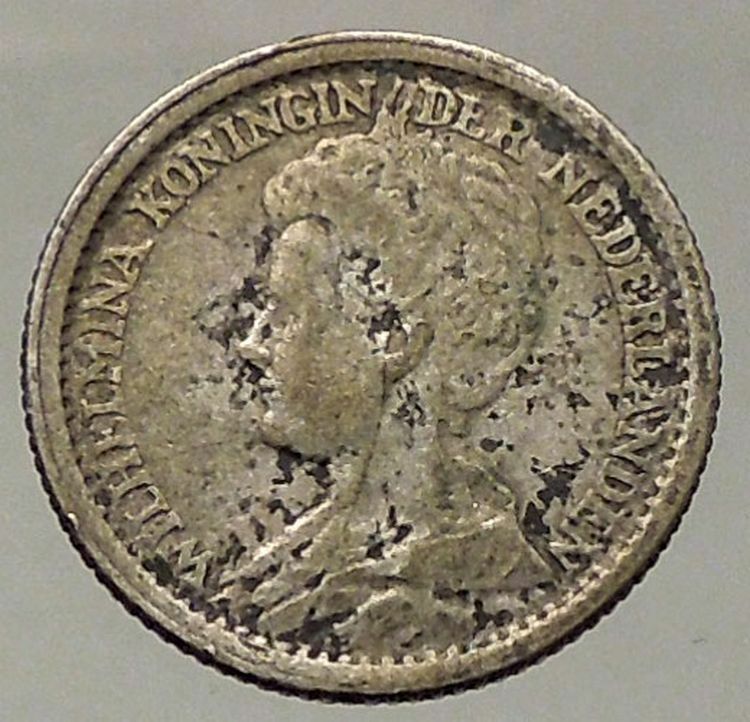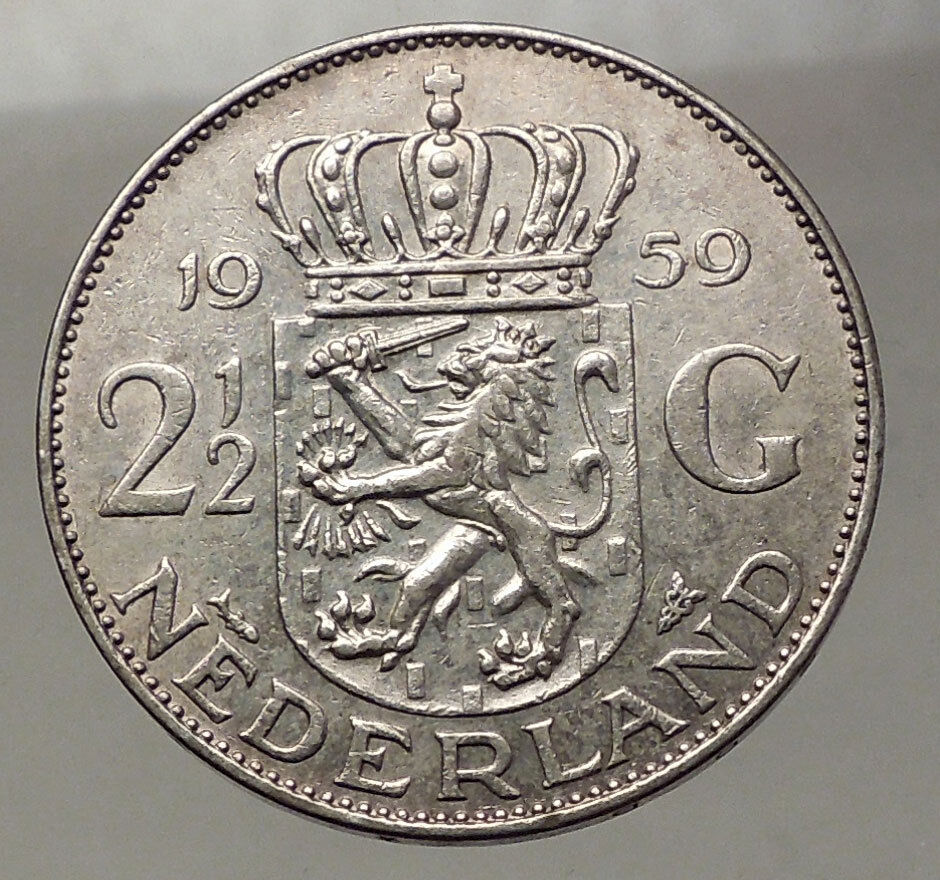|
Curacao under Kingdom of Netherlands
Wilhelmina – Queen November 1890 – 4 September 1948
1944 D Silver 1 Gulden 27mm (9.87 grams) 0.720 Silver (0.230 oz. ASW) Denver Mint
Reference: KM# 45 Scholt I# 1331, Scholt II# 1396, Schön# 37
WILHELMINA KONINGIN DER NEDERLANDEN, Head of Queen Wilhelmina left.
◦◦ MUNT VAN CURACAO, Crowned coat-of-arms; 1 G across fields, year below.
You are bidding on the exact item pictured, provided with a Certificate of Authenticity and Lifetime Guarantee of Authenticity.
 Wilhelmina (Wilhelmina Helena Pauline Maria; 31 August 1880 – 28 November 1962) was Queen of the Kingdom of the Netherlands from 1890 to 1948. She reigned for nearly 58 years, longer than any other Dutch monarch. Her reign saw World War I and World War II , the economic crisis of 1933 , and the decline of the Netherlands as a major colonial power . Outside the Netherlands she is primarily remembered for her role in World War II, in which she proved to be a great inspiration to the Dutch resistance. Wilhelmina (Wilhelmina Helena Pauline Maria; 31 August 1880 – 28 November 1962) was Queen of the Kingdom of the Netherlands from 1890 to 1948. She reigned for nearly 58 years, longer than any other Dutch monarch. Her reign saw World War I and World War II , the economic crisis of 1933 , and the decline of the Netherlands as a major colonial power . Outside the Netherlands she is primarily remembered for her role in World War II, in which she proved to be a great inspiration to the Dutch resistance.
Wilhelmina was well aware what was expected of her by the Dutch people and their elected representatives. At the same time, she was a strong-willed and forceful personality who spoke and acted her mind. These qualities showed up early in her reign when, at the age of 20, Queen Wilhelmina ordered a Dutch warship, HNLMS Gelderland, to South Africa to evacuate Paul Kruger, the embattled President of the Transvaal.
Wilhelmina had a stern dislike of the United Kingdom partly as a result of the annexation of the republics of Transvaal and Orange Free State in the Boer War. The Boers were descendants of early Dutch colonists, to whom Wilhelmina and the people of the Netherlands felt very closely linked. In conversation with her former governess Elisabeth Saxton Winter, she once teasingly referred to the Boer soldiers as “excellent shots”. She was not amused to hear that a Dutch medical relief team was planning to accommodate the needs of both Boer and British wounded soldiers. Nevertheless, in 1940, King George VI sent the warship HMS Hereward, to rescue Wilhelmina, her family and her Government and bring them to safety to the United Kingdom, which offered the Netherlands facilities including broadcasting time on the BBC.
Queen Wilhelmina also had a keen understanding of business matters and her investments made her the world’s richest woman, as well as the world’s first female billionaire (in United States dollars).
Before the First World War started, the young Wilhelmina visited the powerful German Emperor Wilhelm II. The Emperor thought he could impress the queen of a relatively small country by telling her, “My guards are seven feet tall and yours are only shoulder-high to them.” Wilhelmina smiled politely and replied, “Quite true, Your Majesty, your guards are seven feet tall. But when we open our dikes, the water is ten feet deep!”
 Curaçao is an island country in the southern Caribbean Sea , approximately 65 kilometres (40 mi) north of the Venezuelan coast, that is a constituent country (Dutch: land) of the Kingdom of the Netherlands . Formally called the Country of Curaçao, (Dutch: Land Curaçao; Papiamento : Pais Kòrsou), it includes the main island and the uninhabited island of Klein Curaçao (“Little Curaçao”). It has a population of over 150,000 on an area of 444 km2 (171 sq mi) and its capital is Willemstad . Curaçao is an island country in the southern Caribbean Sea , approximately 65 kilometres (40 mi) north of the Venezuelan coast, that is a constituent country (Dutch: land) of the Kingdom of the Netherlands . Formally called the Country of Curaçao, (Dutch: Land Curaçao; Papiamento : Pais Kòrsou), it includes the main island and the uninhabited island of Klein Curaçao (“Little Curaçao”). It has a population of over 150,000 on an area of 444 km2 (171 sq mi) and its capital is Willemstad .
Before the dissolution of the Netherlands Antilles on 10 October 2010, Curaçao was administered as the “Island Territory of Curaçao” (Dutch: Eilandgebied Curaçao, Papiamentu: Teritorio Insular di Kòrsou), one of five island territories of the former Netherlands Antilles.
The Kingdom of the Netherlands, commonly known as the Netherlands, is a sovereign state and constitutional monarchy with territory in western Europe and in the Caribbean.
  The four parts of the Kingdom – Aruba, Cura?o, Sint Maarten and the Netherlands – are constituent countries (landen in Dutch) and participate on a basis of equality as partners in the Kingdom. In practice, however, most of the Kingdom affairs are administered by the Netherlands – which comprises roughly 98% of the Kingdom’s land area and population – on behalf of the entire Kingdom. Consequently, the countries of Aruba, Cura?o, and Sint Maarten are dependent on the Netherlands for matters like foreign policy and defence, although they are autonomous to a certain degree with their own parliaments. The four parts of the Kingdom – Aruba, Cura?o, Sint Maarten and the Netherlands – are constituent countries (landen in Dutch) and participate on a basis of equality as partners in the Kingdom. In practice, however, most of the Kingdom affairs are administered by the Netherlands – which comprises roughly 98% of the Kingdom’s land area and population – on behalf of the entire Kingdom. Consequently, the countries of Aruba, Cura?o, and Sint Maarten are dependent on the Netherlands for matters like foreign policy and defence, although they are autonomous to a certain degree with their own parliaments.
The vast majority in land area of the constituent country of the Netherlands (as well as the Kingdom) is located in Europe, with the exception of the Caribbean Netherlands: its three special municipalities (Bonaire, Saba, and Sint Eustatius) that are located in the Caribbean. The constituent countries of Aruba, Cura?o, and Sint Maarten are located in the Caribbean as well.
|








 The four parts of the Kingdom – Aruba, Cura?o, Sint Maarten and the Netherlands – are constituent countries (landen in Dutch) and participate on a basis of equality as partners in the Kingdom. In practice, however, most of the Kingdom affairs are administered by the Netherlands – which comprises roughly 98% of the Kingdom’s land area and population – on behalf of the entire Kingdom. Consequently, the countries of Aruba, Cura?o, and Sint Maarten are dependent on the Netherlands for matters like foreign policy and defence, although they are autonomous to a certain degree with their own parliaments.
The four parts of the Kingdom – Aruba, Cura?o, Sint Maarten and the Netherlands – are constituent countries (landen in Dutch) and participate on a basis of equality as partners in the Kingdom. In practice, however, most of the Kingdom affairs are administered by the Netherlands – which comprises roughly 98% of the Kingdom’s land area and population – on behalf of the entire Kingdom. Consequently, the countries of Aruba, Cura?o, and Sint Maarten are dependent on the Netherlands for matters like foreign policy and defence, although they are autonomous to a certain degree with their own parliaments.




